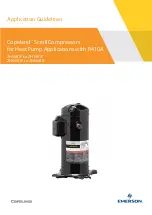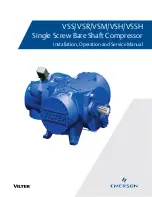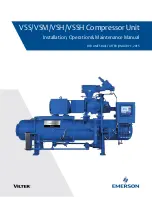
ST16135-00C
3
2
Safety
2
Safety
2.1
General Health and Safety Precautions
Please read carefully and proceed in accordance with the
following instructions before installation, operation,
maintenance or repair of the compressor unit.
2.2
The Health and Safety at Work Act, 1974
In order to comply with your responsibilities under the above act, it
is essential that the compressor is transported, positioned,
installed, operated and maintained by competent persons in
accordance with the instructions in this Handbook.
The standard build of all Hydrovane products are designed to
compress clean, dry, atmospheric air and are not intended for use
in either Explosive or Potentially Explosive Atmospheres as
defined in the ATEX Directive 94/9/EC.
A potentially Explosive atmosphere is an atmosphere which could
become explosive due to local and operational conditions.
The compressor warranty will be invalidated if unapproved spare
parts or oils are used. Using such items may cause the efficiency
and service life of the compressor to be reduced, and could create
a hazardous condition over which Hydrovane has no control.
Failure to maintain the compressor correctly, or modifying it
without prior approval from Hydrovane, may also create a
hazardous condition. This will also invalidate the warranty.
Read and fully understand the contents contained in the User
Handbook.
Ensure that the User Handbook is not permanently removed from
the compressor.
Check that there are no signs of damage and/or oil leaks from the
compressor, cooler and associated pipework.
After completing work, tools and foreign matter should be
removed from the compressor and its surrounding area.
In the unlikely event of a compressor fire, dry powder or carbon
dioxide fire extinguishers should be used. Never use water.
2.3
Before Working on Compressor
Potentially dangerous voltages are used to power this machine.
Do not carry out any work until the isolator is locked in the off
position. Fit a safety notice to the isolator advising that work is
being carried out and that the isolator must not be switched on. If
in doubt, a qualified electrician may remove the fuses and keep
them in a secure place until work is complete.
Ensure the compressor has been safely isolated from the main air
system and cannot be re-introduced until all work has been
completed. Fit a safety notice to the isolation valve advising that
work is being carried out.
Do not undertake any work until the compressor and receiver, if
fitted, have been relieved of all pressure.
Wait until the compressor’s vent down cycle is complete.
Release any pressure contained in the aftercooler or associated
pipework.
Check that the compressor pressure gauge reads zero. Do not
proceed until it does.
Carefully unscrew the compressor filler plug. If any air or oil
escapes before the plug is fully removed stop! Do not remove the
plug until all pressure is lost.
Safety devices fitted to the compressor or pipework system
should be checked at regular intervals and replaced if faulty. They
should not be tampered with or modified. Non return valves
should not be used as isolation devices.
To ensure the compressor operates safely you must carry out the
specified maintenance procedures.
Only approved oils should be used for flushing purposes.
Extreme caution should be taken if the compressor has been
subjected to severe operating temperatures or fire. Certain
components may contain fluoroelastomer materials and under
these conditions can leave extremely corrosive residues. Severe
burns and permanent skin and tissue damage can be a result of
skin contact.
The Health and Safety information contained in this Handbook is
only intended to give general guidelines.
2.4
When Operating the Compressor
When in automatic mode the compressor may restart without
warning.
Additional warnings will be required if the unit is configured for
remote stop/start or to restart after power failure.
Do not remove any plugs or release pipework when the
compressor is running.
Do not attempt to open the starter enclosure while the compressor
is operating.
Beware of hot surfaces, both the compressor and electric motor
are designed to run at elevated temperatures.
Compressed air is potentially dangerous and can be fatal if
misused. Do not allow compressed air jets, discharged from any
pipe or nozzle, to make contact with your body.
Wear safety glasses and suitable clothing when using or working
in an area where compressed air is being used.
Hazardous vapours/fumes can be produced if compressed air is
used to remove chemicals, cleaning agents and oils from
equipment and components. Suitable respiratory and extraction
equipment may be required in these circumstances. Never use
compressed air for cleaning personal clothing.
Air discharged from compressors is unsuitable for breathing
purposes. Air for human consumption must be subjected to further
treatment to ensure that contaminant levels for odour and
moisture content meet the requirements of BS 4275 1974.
We recommend that air supply to hand-held air guns is regulated
to a lower pressure (refer to local Health and Safety regulations).
Do not insert any object or any part of your body through any
opening of the compressor enclosure. Serious personal injury
and/or damage may result.








































